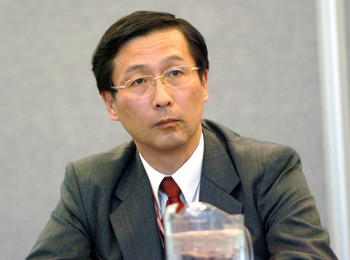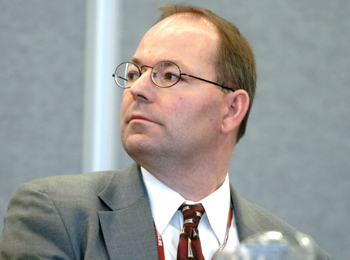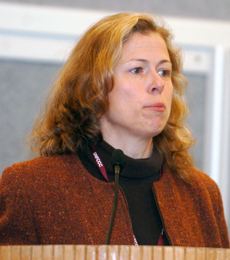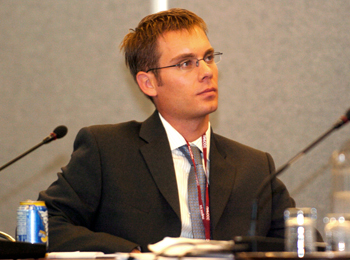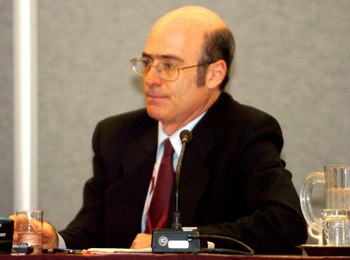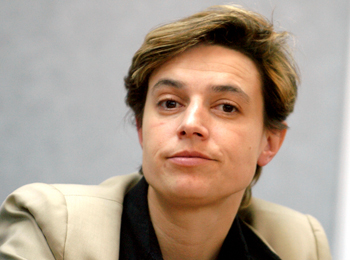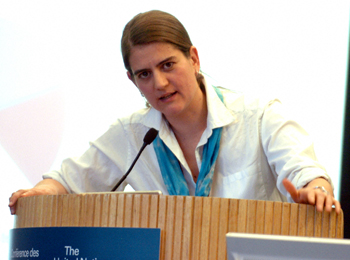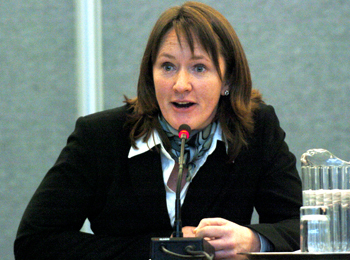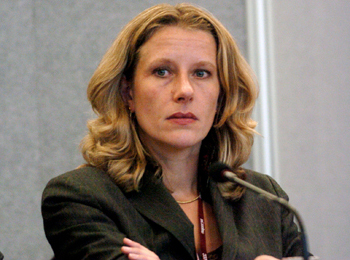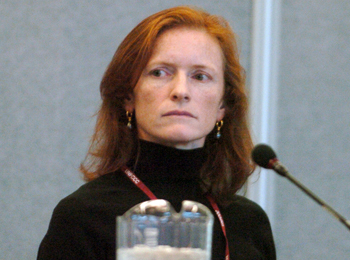 |
||
|
published by IISD, the International Institute for Sustainable Development
in cooperation with the UNFCCC Secretariat. |
|||
|
Special Report on Selected Side Events at COP 11 & Kyoto Protocol COP/MOP 1
|
|||||
| 28 November - 9 December 2005 | Montréal, Canada | |||||
|
Technology in action Presented by the International Chamber of Commerce |
|||
|
Arthur Smith, NiSource, described the combined heat and power technology developed by his company, which manufactures micro turbines for commercial, institutional and small industrial customers. He noted that this highly efficient technology is compatible with solar and fuel cell usage.
David Schnaars, Solar Turbines, detailed the advantages of gas turbines produced by his company, underscoring their high efficiency, and low carbon emissions profile and maintenance costs. Thomas Weber, Jupiter Oxygen Corporation, explained how Oxy-Fuel technology enables a 70% reduction in carbon dioxide emissions by using pure oxygen and eliminating nitrogen from combustion, which in turn reduces production costs and pollution. Mark Schoenfield, Jupiter Oxygen Corporation, addressed the transfer of the Oxy-Fuel technology to other uses, including steam generation and coal fired power plants. He explained that this technology makes carbon dioxide more concentrated, which renders its capture easier and cheaper, as recognized by the IPCC. Yoshito Izumi, Taiheiyo Cement Corporation, outlined carbon dioxide reduction opportunities in the cement industry, including efficient technologies and transition from wet to dry kilns. He stressed the importance of transferring these technologies to China and India, that represent 50% of cement production worldwide. Masayuki Sasanouchi, Toyota Motor Corporation, argued that the automobile industry should improve its performance in response to the increase in emissions from consumers. He listed some examples of clean technologies, such as fuel cells, and indicated that a market-based approach is the most effective in diversifying technologies. Noting the increase in energy consumption, Nicole Dellero, Areva, described the advances in nuclear sector, including daily controlled risks at the installations, waste management, and safety. She indicated that nuclear energy represents a 10% carbon dioxide emission reduction worldwide, and argued that nuclear power generation already contributes to greenhouse gas (GHG) mitigation and could be further developed. Nick Campbell, ICC, emphasized that the majority of research in the field of clean technology is carried out by profitable businesses and that their transfer should be enhanced. Discussion: Sasanouchi underlined the importance of consumer acceptance, explaining that a demand for increased acceleration power of hybrid vehicles implies increased emissions. Participants also discussed obstacles to transferring clean technologies to Chinese and Indian cement industries. |
|||
|
|||
|
||||||||||||||||||||||||||||||||||
|
|||
|
|
|||
|
Enhancing climate knowledge to improve adaptation to climate variability and change Presented by the World Meteorological Organization |
|||||
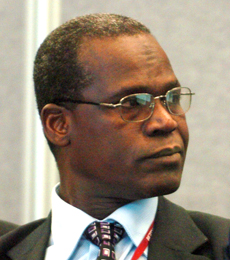 |
Buruhani Nyenzi, World Meteorological Organization (WMO), noted that climate knowledge plays an important role in managing and mitigating risks to achieve sustainable development.
Don Maclver, Meteorological Service, Canada, underscored the need to develop higher resolution climate models that would facilitate anticipatory action for adaptation. Hong Yan, WMO, provided an overview of some of WMO’s adaptation activities, including climate observation and data management, and climate research, modeling and prediction. Neil Ward, International Research Institute for Climate and Society, provided examples of collaborative adaptation projects such as the management of the Angat Dam reservoir in the Philippines. David Walland, Australian Bureau of Meteorology, highlighted a number of adaptation projects in Pacific Island countries, and noted the importance of national meteorological service for local stakeholders. |
||||
| Mama Konate, National Meteorological Services, Mali, stated that without climate information a farmer is like a mouse in a bottle | |||||
|
Christopher Oludhe, Climate Prediction and Applications Center, Kenya, described his organization’s initiatives to cope with climate variability in the Greater Horn of Africa, such as on early warning. Patricia Ramirez Obando, Central American Integration System, Costa Rica, highlighted actions taken by stakeholders to reduce vulnerability of communities in Costa Rica. Mama Konate, National Meteorological Services, Mali, noted the use of meteorological information in building adaptative capacity of small farmers in Mali. Discussion: participants noted the importance of including indigenous knowledge and local data in climate modeling and decision-making. |
|||||
|
|||
|
Market Perspectives on the CDM Reforms Presented by the Business Council for Sustainable Energy |
|||||||
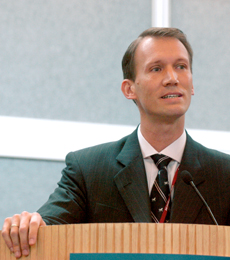 |
Tod Delaney, Business Council for Sustainable Energy (BCSE), provided a brief overview of the BCSE and its position regarding the CDM.
Dick Ballhorn, Department of Foreign Affairs and International Trade, Canada, expressed hope for better funding of the Executive Board (EB), incorporation of changes in the additionality tool, and institutional reform of the CDM EB. Marcelo Junqueira, Econergy Brazil, highlighted his company’s CDM initiatives and regretted that the CDM approval process is time consuming, complex and bureaucratic. Julie Smith, Enel North America, highlighted the need for clarity in the definition of sustainable development criteria and CDM project eligibility. Mark Trexler, Trexler Climate and Energy Services, emphasized that additionality cannot be maximized for all criteria and thus policymakers need to specify them. Steve Koch, NAIMA Canada, noted the need for adopting simple and clear rules for project developers and certifiers. |
||||||
| Marcelo Junqueira, Econergy, expressed frustration that the approval of one of their project methodologies by the CDM Executive Board took a long period of 18 months | |||||||
|
John Drexhage, IISD, noted that the CDM has great potential to deliver development oriented benefits, “a development dividend,” provided that certain reforms are instituted. John Kadyszewski, Winrock International, highlighted that it is possible to tune the CDM process to prioritize sectors where development benefits are the greatest. Nancy Bacon, Energy Conversion Devices, illustrated their project on a new photovoltaic technology and questioned how renewable energy technologies could be included in the CDM. |
|||||||
|
|||
|
Geothermal energy: available technologies and techno-economic potential between 2008 and 2012 Presented by Energy Strategies |
|||||
 |
Hermann Halozan, International Energy Agency, described the objectives and activities of his Agency’s heat pump (HP) programme, and legal and economic barriers to overcome.
Shawn Xu, University of Missouri-Columbia, noted energy savings that could be achieved if China adopted HPs on a large scale. He highlighted the cost-efficiency of HPs, and noted obstacles to adoption such as high densities and lack of a trained labor force. He described penetration strategies, including technology transfer and development, and new energy management contracts. Martina Höller, Austrian Heat Pump Association, described her Association’s activities, including lobbying, training and consumer education. She said that high oil prices and concern for the environment have set favorable conditions, but highlighted competition between renewable sources. Wael El-Sharif, Geothermal HP Consortium, noted the rapid adoption of HPs in the US and resultant energy savings, and outlined government programs that have addressed concerns over high initial costs, and lack of training and awareness. |
||||
| Shawn Xu, University of Missouri-Columbia, noted that the size of the Chinese market holds great potential for energy savings achieved through the introduction of heat pumps | |||||
| Denis Tanguay, Canadian Geo-Exchange Coalition, said infrastructure savings should also be considered in addition to energy savings, and that this technology could help weather fluctuations in oil costs. | |||||
|
|||
|
Preparing for climate change Presented by the University of East Anglia |
|||
|
Emily Boyd, Stockholm University, presented research findings on various adaptation activities in the UK, emphasizing that adaptation, while occurring, is difficult to achieve. She noted the difficulty of evaluating the cost of adaptation and called for mechanisms to support local adaptations.
Henny Osbahr, Oxford University, highlighted key findings of the ADAPTIVE project which examined elements for successful adaptation to climate change in natural resource dependent communities. Irene Lorenzoni, University of East Anglia, described how people’s perception of the dangers of climate change affects their response. She stated that individuals respond to short-term events, but do not make long term behavioral shifts and that climate change is not viewed as dangerous at the individual level. She called for simultaneous structural changes throughout society to promote adaptation. Emma Tompkins, Tyndall Centre, outlined actions to survive climate change in small islands including reducing physical and social vulnerability through local management. Noting that enough information exists, she urged taking immediate preparedness actions. Discussion: participants addressed: the transferability of successful adaptation strategies; acceptance of climate change over time; effective individual action; monitoring adaptation; and the link between adaptation and mitigation. |
|||
|
|||
|
Action targets: a new form of climate commitment Presented by the Center for International Environmental Law |
|||||||
| Donald Goldberg, Center for International Environmental Law (CIEL), defined an action target as an obligation to achieve a specific quantity of abatement rather than a future emission level. He said compliance involves verifying the achievement of a pre-agreed amount of reduction. Anne Niederberger, Policy Solutions, discussed the Swiss “Climate Cent” programme by which oil importers assume the full obligation for transport sector emissions by contributing 1-2 Swiss cents per liter into the Climate Penny Fund which they invest annually to achieve or acquire emissions reductions. Ned Helme, Center for Clean Air Policy, proposed a sectoral-based approach with countries promising to achieve specific carbon intensity targets, for which financing would be available, and to which no penalties are attached. Charlotte Streck, Climate Focus, said that all these approaches propose instruments that are fair, robust, feasible, and politically viable for all countries. She noted consensus on the need for a trading system and a voluntary approach. |
|||||||
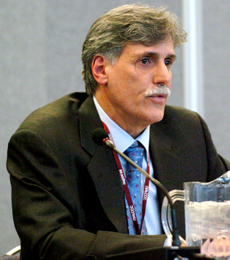 |
|||||||
| Don Goldberg, Center for International Environmental Law (CIEL) details the action target approach | |||||||
|
|||
|
||
|
Click the above button to go back to our ENB main coverage
|
||
|
|
|
|
|
||
|



